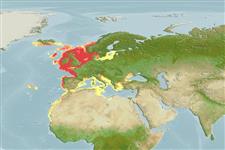>
Callionymiformes (Dragonets) >
Callionymidae (Dragonets)
Etymology: Callionymus: Greek, kallion, comparative of kallos = beautiful + Greek, onyma = name; with a better name .
More on author: Linnaeus.
Environment: milieu / climate zone / depth range / distribution range
Ecologia
marinhas demersal; intervalo de profundidade 1 - 440 m (Ref. 5968), usually 5 - 30 m (Ref. 27115). Temperate; 16°C - 20°C (Ref. 27115); 66°N - 16°N, 42°W - 42°E
Eastern Atlantic: southern Iceland and Norway south to Mauritania, including the northern Mediterranean, Gibraltar, and Algeria, western Black Sea, Aegean and Adriatic Sea, Azores and the Canary Islands.
Length at first maturity / Tamanho / Peso / Idade
Maturity: Lm 17.4 range ? - ? cm
Max length : 30.5 cm TL macho/indeterminado; (Ref. 59122); 25.0 cm TL (female); common length : 15.0 cm TL macho/indeterminado; (Ref. 3397); Idade máx. registada: 7 anos (Ref. 72462)
Espinhos dorsais (total): 4; Raios dorsais moles (total): 8-10; Raios anais moles: 9. Gill opening dorsal. Usually antrorse (forward-pointing) tip at base of preopercular spine. Rays of second dorsal unbranched except for the last, which is divided at base (Ref. 232). Snout length 2-3 times the diameter of the eye (Ref. 35388).
Occurs on sand and muddy bottoms from sublittoral to 200 m (Ref. 6444) and to 400 m or more (Ref. 9900). Feeds on small invertebrates, mainly worms and crustaceans. Territorial, males aggressive with each other. Complex courtship behavior consists of 4 phases: courtship, pairing, ascending, releasing eggs and milt. Pelagic eggs and larvae (Ref. 5968). Minimum depth reported from Ref. 27115. Neither opercular spine gland nor anterolateral glandular groove with venom gland is present (Ref. 57406).
Complex courtship behavior with 4 phases: courtship, pairing, ascending, releasing eggs and milt (Ref. 5968).
Davis, W.P and R. Fricke, 1990. Callionymidae. p. 921-924. In J.C. Quero, J.C. Hureau, C. Karrer, A. Post and L. Saldanha (eds.) Check-list of the fishes of the eastern tropical Atlantic (CLOFETA). JNICT, Lisbon, SEI, Paris; and UNESCO, Paris. Vol. 2. (Ref. 6941)
Categoria na Lista Vermelha da IUCN (Ref. 130435)
Utilização humana
Pescarias: pouco comercial; Aquário: Aquários públicos
Mais informação
ReferênciasAquaculturaPerfil para aquaculturaEstirpesGenéticaElectrophoresesHereditariedadeDoençasProcessamentoNutrientsMass conversion
Ferramentas
Relatórios especiais
Descarregue XML
Fontes da internet
Estimates based on models
Preferred temperature (Ref.
123201): 11.7 - 19.5, mean 13.3 °C (based on 92 cells).
Phylogenetic diversity index (Ref.
82804): PD
50 = 0.5000 [Uniqueness, from 0.5 = low to 2.0 = high].
Bayesian length-weight: a=0.01096 (0.00905 - 0.01329), b=2.76 (2.71 - 2.81), in cm total length, based on LWR estimates for this species (Ref.
93245).
Nível Trófico (Ref.
69278): 3.3 ±0.38 se; based on food items.
Generation time: 2.6 ( na - na) years. Estimated as median ln(3)/K based on 2
growth studies.
Resiliência (Ref.
120179): Médio, tempo mínimo de duplicação da população 1,4 - 4,4 anos (K=0.43-0.47; tmax=6).
Fishing Vulnerability (Ref.
59153): Low to moderate vulnerability (29 of 100).
Nutrients (Ref.
124155): Calcium = 54.2 [31.1, 99.0] mg/100g; Iron = 0.386 [0.218, 0.684] mg/100g; Protein = 17.9 [17.0, 18.8] %; Omega3 = 0.478 [0.259, 0.840] g/100g; Selenium = 18.5 [9.3, 38.6] μg/100g; VitaminA = 13.4 [3.7, 47.5] μg/100g; Zinc = 0.617 [0.442, 0.885] mg/100g (wet weight);
